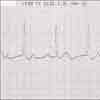Case in Point: Heart Block as the Presenting Symptom of Lyme Disease
A 16-year-old girl presented to the emergency department (ED) with a 24-hour history of feeling tired and weak. The patient reported that she awoke that morning with the "worst headache of her life" and "passed out" while sitting on the edge of her bed. She did not tell her friends or family.

A 16-year-old girl presented to the emergency department (ED) with a 24-hour history of feeling tired and weak. The patient reported that she awoke that morning with the "worst headache of her life" and "passed out" while sitting on the edge of her bed. She did not tell her friends or family.
The headache persisted in the frontal region and was unrelieved by acetaminophen. While at lunch with a group of friends, she slumped over in her chair and became unresponsive for 30 seconds. During this episode, the patient was not incontinent nor did she have any abnormal movements consistent with an overt seizure. After the event, she was awake and alert and was brought by ambulance to the ED.
The patient had been healthy before this episode and had no significant medical history. Her family history was noncontributory for any genetic components or illnesses. She lived with her parents and 2 healthy siblings in Rhode Island. Her activities included lifeguarding at a town beach and bike riding. She reported that the only medication she took was acetaminophen. A full adolescent HEADSS assessment (Home, Education, Activities, Drugs, Sexual history, Suicidality/depression) did not reveal any contributory findings to explain this patient's syncopal episodes. She denied any new symptoms other than fatigue and a constant frontal headache. There was no history of nausea, vomiting, neck stiffness, or photophobia, nor were there complaints of chest, abdominal, or joint pain. She did not remember any insect bites or rashes occurring during the past month.
In the ED, the patient was awake and alert with a frontal headache. Her vital signs were normal and stable. Heart rate, 62 beats per minute, respiratory rate, 18 breaths per minute; blood pressure, 126/74 mm Hg; and oxygen saturation, 98% on room air. She weighed 54 kg and was 157 cm tall with a normal body mass index of 21.9. Evaluation of the head, eyes, ears, nose, and throat revealed 5-mm bilateral pupils that reacted slowly to light. Extraocular muscle function was intact. Funduscopic findings were normal. Breath sounds were clear bilaterally. Chest assessment revealed an irregular heart rate and rhythm, with a mean of 60 beats per minute and no audible murmur. Abdominal examination findings were normal, with no hepatosplenomegaly. Extremities were warm, without bruises or rashes. The patient's skin was warm and her cheeks were flushed. Mucous membranes were pink and moist. Results of the neurologic examination were grossly normal. Muscle strength was 5+ and symmetric. Deep tendon reflexes were 2+ and symmetric with no focal findings.

The complete blood cell count and levels of electrolytes, blood urea nitrogen, creatinine, glucose, calcium, magnesium, and phosphorus were all within normal limits, as were results of liver function tests. Results of a urinalysis, urine toxicology screen, urine pregnancy test, and a Monospot test were negative.
Given the patient's account of awaking with the worst headache of her life and the possibility of an intracranial process, serial transaxial CT images of the head were obtained from the foramen magnum to the skull vertex. There was no evidence of acute intracerebral hemorrhage, extra-axial fluid collection, midline shift, or mass effect. The ventricles were of normal size, shape, and configuration for the patient's age. The bony calvarium was intact and the paranasal sinuses were well aerated.
Because of the 2 syncopal episodes, an ECG was also obtained (Figure 1). The tracings showed complete heart block with an atrial rate of 100 beats per minute and a ventricular rate of 60 beats per minute. There were narrow QRS complexes and a pause of up to 3.5 seconds on the rhythm strip (Figure 2).
The pediatric cardiology service was consulted. An echocardiogram showed a structurally normal heart with good biventricular shortening function. There was mild mitral valve regurgitation and no pericardial effusion.
Additional laboratory tests were ordered, including those for Lyme disease and creatine phosphokinase. Because Lyme carditis was being considered in the differential diagnosis, intravenous ceftriaxone therapy was initiated. The patient was admitted to the electrophysiology service for monitoring and for possible insertion of a temporary pacemaker.
Test results confirmed the diagnosis of Lyme carditis. Western blot studies for Borrelia burgdorferi IgG antibodies were positive for bands 18, 23, 39, 41, 45, and 58. (IgG antibodies to any 5 of the following 10 significant bands is considered a positive result: 18, 23, 28, 30, 39, 41, 45, 58, 66, or 93kDa.) Western blot studies for IgM antibodies were positive on all 3 bands. (IgM antibodies to any 2 of the following 3 significant bands is considered a positive result: 23, 39, and 41kDa.) There were no Ehrlichia IgG or IgM antibodies or Babesia IgM antibodies.
The infectious disease service was consulted and a lumbar puncture was recommended to assess for neuroborreliosis. Results of polymerase chain reaction assays for Lyme disease in the cerebrospinal fluid were negative. Lyme total antibody test with reflex was positive at 3.52 immune status ratio (ISR). (A result of 1.10 ISR or greater is considered positive.) This panel is appropriate for Lyme disease testing 4 weeks after a diagnosis of erythema migrans or the onset of disease symptoms.
The patient was admitted to a general ward, where a high-grade atrioventricular (AV) block subsequently developed. She required transcutaneous pacing and a transvenous pacemaker, which remained in place for approximately 14 hours. Thereafter, the patient's rhythm became a 2:1 AV block and then a first-degree AV block. The transvenous pacemak-er was removed and the patient was closely monitored via telemetry. She had no further episodes of high-grade AV block.
The patient received 28 days of ceftriaxone therapy and was advised to follow up with her primary care provider and cardiologist.
Lyme Carditis
Lyme disease is a tick-borne illness caused by the spirochete B burgdorferi. These bacteria are transmitted by deer ticks of the Ixodes species (Ixodes scapularis on the East Coast of the United States and Ixodes pacificus on the West Coast). Complications involving the joints, CNS, and cardiovascular system ensue if the infection is undetected or untreated.
Each year, more and more reported cases of Lyme disease and its sequelae have been reported. In 2001, 17,029 cases of Lyme disease were reported to the CDC by 43 states and the District of Columbia. This translated into a national incidence of 6.0 cases per 100,000 population. In 2002, the number of reported cases increased by 40%, to 23,763 cases, yielding a national incidence of 8.2 cases per 100,000 population.1
Cardiovascular manifestations of untreated Lyme disease often occur within 21 days of exposure and include fluctuating degrees of AV block, acute myopericarditis or mild left ventricular dysfunction, and rarely, cardiomegaly or fatal pericarditis.2 Carditis occurs in approximately 4% to 10% of untreated adults--and in a much lower proportion of children in the United States.3 (In one prospective, longitudinal, community-based cohort study of 201 children [1 to 21 years old] with newly diagnosed Lyme disease, carditis developed in only 0.5%.4)Neurologic involvement, which can affect up to 15% of untreated patients, can include facial nerve palsy (Bell palsy) and aseptic meningitis; less commonly, cerebellar ataxia, radiculoneuritis, myeli-tis, and pseudotumor cerebri may develop.5
Timely diagnosis of Lyme carditis rests on including this disorder in the differential when an adolescent presents with a syncopal episode. In this patient's case, confounding factors such as severe headache made the diagnosis somewhat harder. Some patients have no history or findings that suggest Lyme disease. In some cases, for example, heart block is the first and only manifestation of Lyme disease.6
The diagnosis of Lyme carditis is confirmed by the association of clinical features with serologic testing, including enzyme-linked immunosorbent assay and/or Western blot analysis. However, Lyme carditis can occur early in the course of Lyme disease, before there has been a detectable antibody response (which typically occurs at 6 to 8 weeks). Thus, a negative test result does not rule out the diagnosis. However, if cardiac features have been present for more than 1 to 2 months, the patient should be seropositive and a negative test result should cast doubt on the diagnosis of Lyme carditis.3
No studies have specifically addressed the treatment of Lyme carditis. Although there is no evidence that antibiotic therapy hastens the resolution of cardiac abnormalities, such therapy is recommended for affected patients with this purpose in mind and to prevent later manifestations of Lyme disease.3 There are no comparative treatment trials in carditis, and there is no evidence to suggest that parenteral antibiotic therapy is more effective than oral antibiotic therapy (Table).7
For patients with Lyme carditis, the prognosis remains positive, and spontaneous resolution of heart block can be expected within a few days or weeks. There have been cases (like this one), in which temporary pacing is required.
Prevention still remains the best defense against Lyme disease. The CDC recommends using insect repellent with 20% to 30% N,N-diethyl-m-toluamide (DEET) on adult skin and clothing and avoiding wooded areas--especially in the summer months. According to the American Academy of Pediatrics, tick and insect repellents that contain DEET provide additional protection but require reapplication every 1 to 2 hours for maximum effectiveness.8 Although serious neurologic complications in children resulting from the frequent and excessive application of DEET-containing repellents have been reported, they are rare, and the risk is low when these compounds are used according to product label instructions. Therefore, DEET should be applied sparingly; according to product label instructions; only to exposed skin; and not to a child's face, hands, or skin that is irritated or abraded. After the child returns indoors, treated skin should be washed with soap and water. Concentrations of DEET greater than 30% usually are not necessary.
For practitioners, it is essential to be aware of the various presenting symptoms of Lyme disease and its potential sequelae. This patient did not present with the classic early symptoms (eg, erythema migrans), nor did she have chills, fever, muscle and joint aches, or swollen lymph nodes. It was only after the diagnosis of complete heart block was made that the possibility of Lyme disease was considered. This patient made a full recovery after being treated with several weeks of antibiotics. She will be monitored by her primary care provider and cardiologist.
References:
REFERENCES:
1.
Centers for Disease Control and Prevention. Lyme disease--United States, 2001-2002
. MMWR.
2004;53:365-369.
2.
Lo R, Menzies DJ, Archer H, Cohen TJ. Complete heart block due to Lyme carditis.
J Invasive Cardiol.
2003;15:367-369.
3.
Sigal LH. Early disseminated Lyme disease: cardiac manifestations.
Am J Med.
1995;98:25S-28S.
4.
Gerber MA, Shapiro ED, Burke GS, et al. Lyme disease in children in southeastern Connecticut. Pediatric Lyme Disease Study Group.
N Engl J Med.
1996;335:1270-1274
.
5.
Steere AC. Lyme disease.
N Engl J Med.
2001; 345:115-125.
6.
Kimball SA, Janson PA, LaRaia PJ. Complete heart block as the sole presentation of Lyme disease.
Arch Intern Med.
1989;149:1897-1898.
7.
Wormser GP, Dattwyler RJ, Shapiro ED, et al. The clinical assessment, treatment, and prevention of Lyme disease, human granulocytic anaplasmosis, and babesiosis: clinical practice guidelines by the Infectious Diseases Society of America.
Clin Infect Dis.
2006;43:1089-1134.
8.
American Academy of Pediatrics, Committee on Infectious Diseases. Prevention of Lyme disease.
Pediatrics.
2000;105:142-147.
9.
American Academy of Pediatrics. Lyme disease. In: Pickering LK, ed.
Red Book. 2003 Report of the Committee on Infectious Diseases.
26th ed. Elk Grove Village, Ill: American Academy of Pediatrics; 2003:407-411.
Recognize & Refer: Hemangiomas in pediatrics
July 17th 2019Contemporary Pediatrics sits down exclusively with Sheila Fallon Friedlander, MD, a professor dermatology and pediatrics, to discuss the one key condition for which she believes community pediatricians should be especially aware-hemangiomas.


















